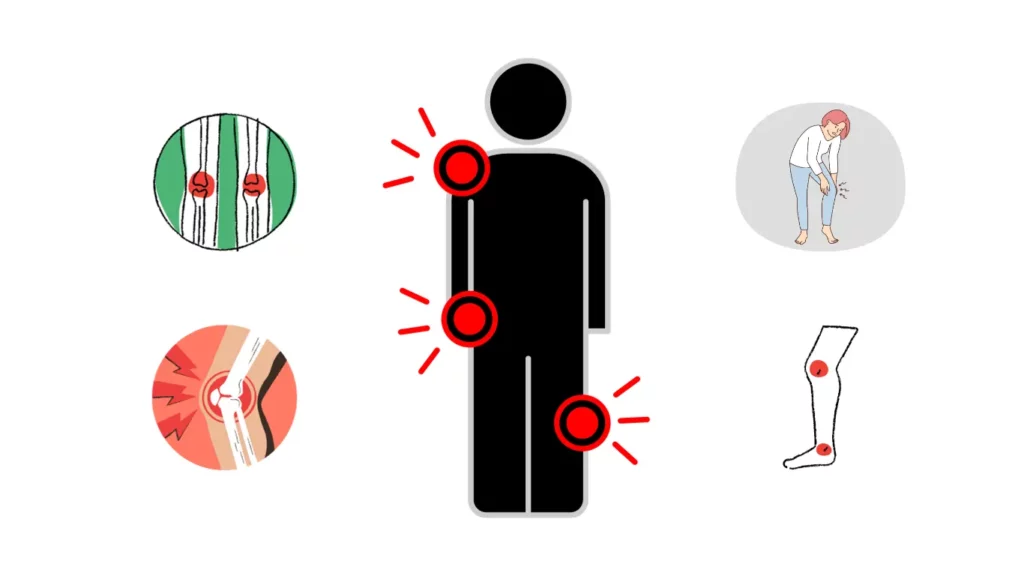What Causes Joint Pain All Over the Body

Joint pain can be a debilitating condition that affects people of all ages. Whether it’s a dull ache or a sharp, shooting pain, discomfort in the joints can significantly impact one’s quality of life. While joint pain can occur in specific areas, it’s not uncommon for individuals to experience pain all over their body. In this article, we will explore the various factors in “What Causes Joint Pain All Over the Body”, from the more common culprits to the less frequent, as well as how to manage and prevent it.
Understanding Joint Pain
Joint pain, also known as arthralgia, refers to discomfort, pain or inflammation in the joints. Joints are the areas where two or more bones meet, allowing for movement. Joint pain can affect any joint in the body, from the fingers and wrists to the knees, hips, and shoulders. When it occurs throughout the body, it can be a source of considerable distress.
What Causes Joint Pain All Over the Body
Common Causes of Joint Pain
Arthritis: Arthritis is one of the most prevalent causes of joint pain. It includes conditions like osteoarthritis and rheumatoid arthritis, which lead to joint inflammation and degeneration.
Injuries: Trauma, such as sports injuries or accidents, can cause joint pain. Strains, sprains, and fractures may result in widespread joint discomfort.
Inflammatory Diseases: Conditions like lupus and other autoimmune diseases can trigger inflammation in multiple joints, leading to widespread pain.
Uncommon Causes of Joint Pain
Infections: Certain infections, such as viral or bacterial infections, can lead to joint pain throughout the body. Conditions like Lyme disease are known for this symptom.
Autoimmune Disorders: Diseases like Sjögren’s syndrome and psoriatic arthritis can cause widespread joint pain as the immune system attacks healthy joints.
Metabolic Disorders: Disorders like gout, which involve the accumulation of uric acid crystals in the joints, can result in pain all over the body.
Read More: Joint Pain and Stiffness: Understanding the Discomfort
Symptoms of Joint Pain
The symptoms of joint pain can vary, but they often include swelling, redness, stiffness, and decreased range of motion. The intensity of pain can also vary from mild discomfort to severe agony.
Diagnosis and Evaluation
To determine the cause of widespread joint pain, a healthcare provider will typically take a detailed medical history, conduct a physical examination, and order imaging and lab tests.
Treatment Options
The treatment of joint pain depends on its underlying cause. Common treatment options include medications, physical therapy, lifestyle modifications, and, in some cases, surgical intervention.
Preventing Joint Pain
Preventing joint pain can be achieved through various means, including maintaining a healthy lifestyle, managing body weight, and regular exercise. These measures can help reduce the risk of joint pain all over the body.
Coping with Chronic Joint Pain
Chronic joint pain can be challenging to live with, but there are strategies for coping, including seeking emotional support, pain management techniques, and adaptive tools to ease daily life.
Conclusion
What Causes Joint Pain All Over the Body?
Joint pain that affects the entire body can be caused by a variety of factors, from common issues like arthritis and injuries to more unusual conditions. Understanding the underlying cause of your joint pain is essential for effective treatment and management. By taking steps to prevent joint pain and seeking timely medical advice, you can improve your quality of life.
Faqs on What Causes Joint Pain All Over the Body
The most common cause of joint pain is arthritis, which includes osteoarthritis and rheumatoid arthritis.
Yes, joint pain can be a symptom of serious conditions, such as autoimmune diseases or infections. It’s essential to seek medical attention for a proper diagnosis.
Diagnosis of joint pain typically involves a medical history review, a physical examination, and, in some cases, imaging and lab tests.
Some people find relief from joint pain through natural remedies like exercise, dietary changes, and supplements, but it’s essential to consult with a healthcare provider.
If you are experiencing persistent or severe joint pain all over your body, it’s advisable to consult a doctor for an accurate diagnosis and treatment recommendations.


